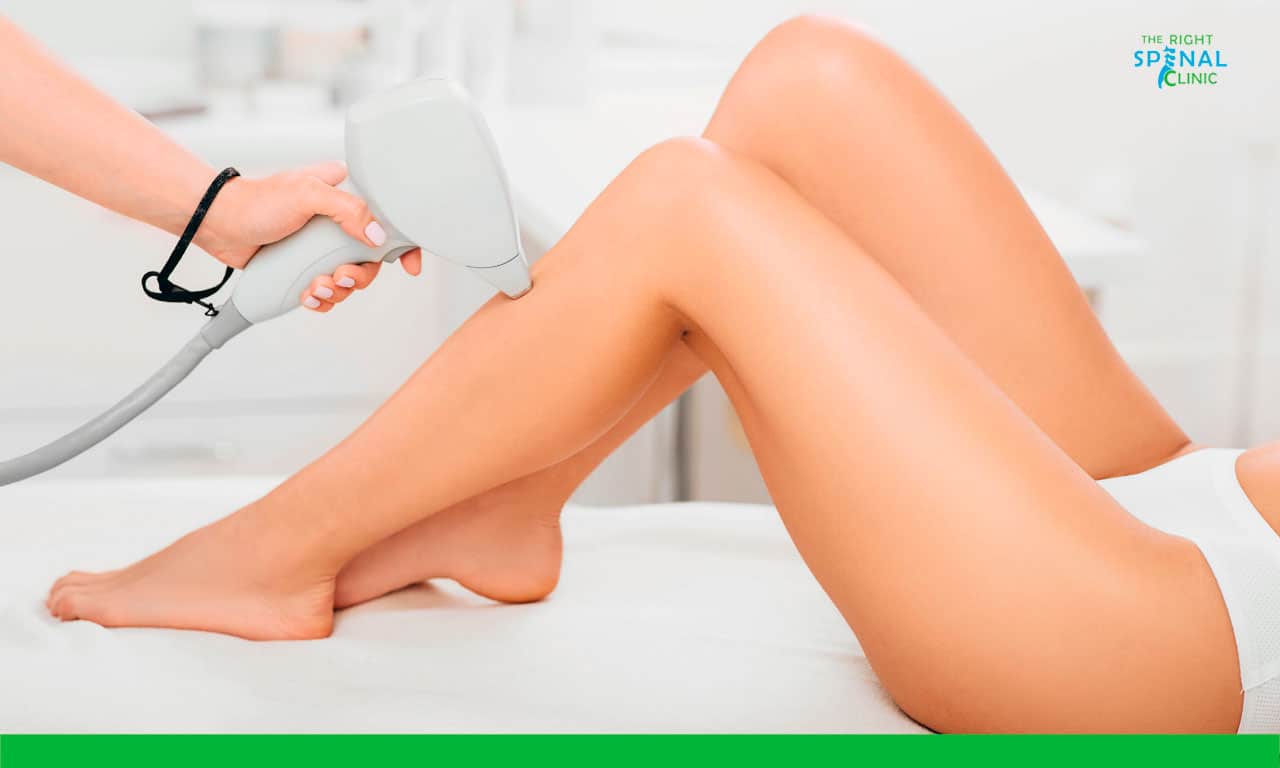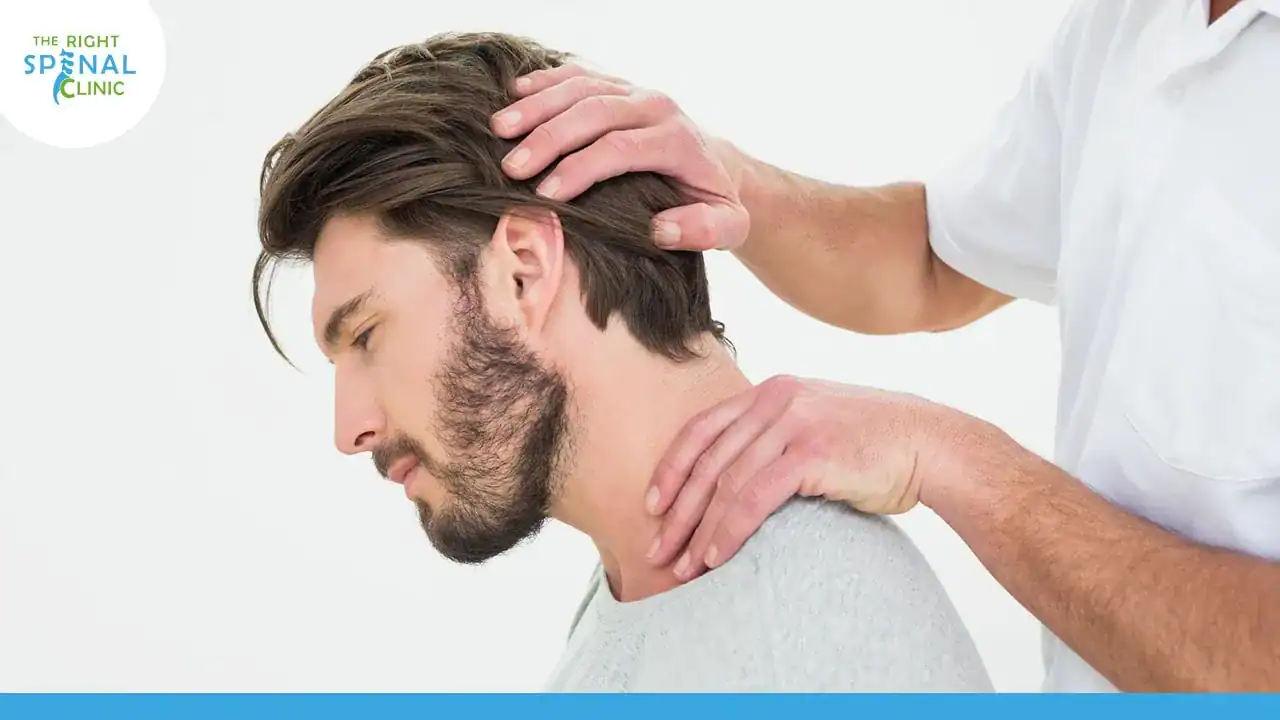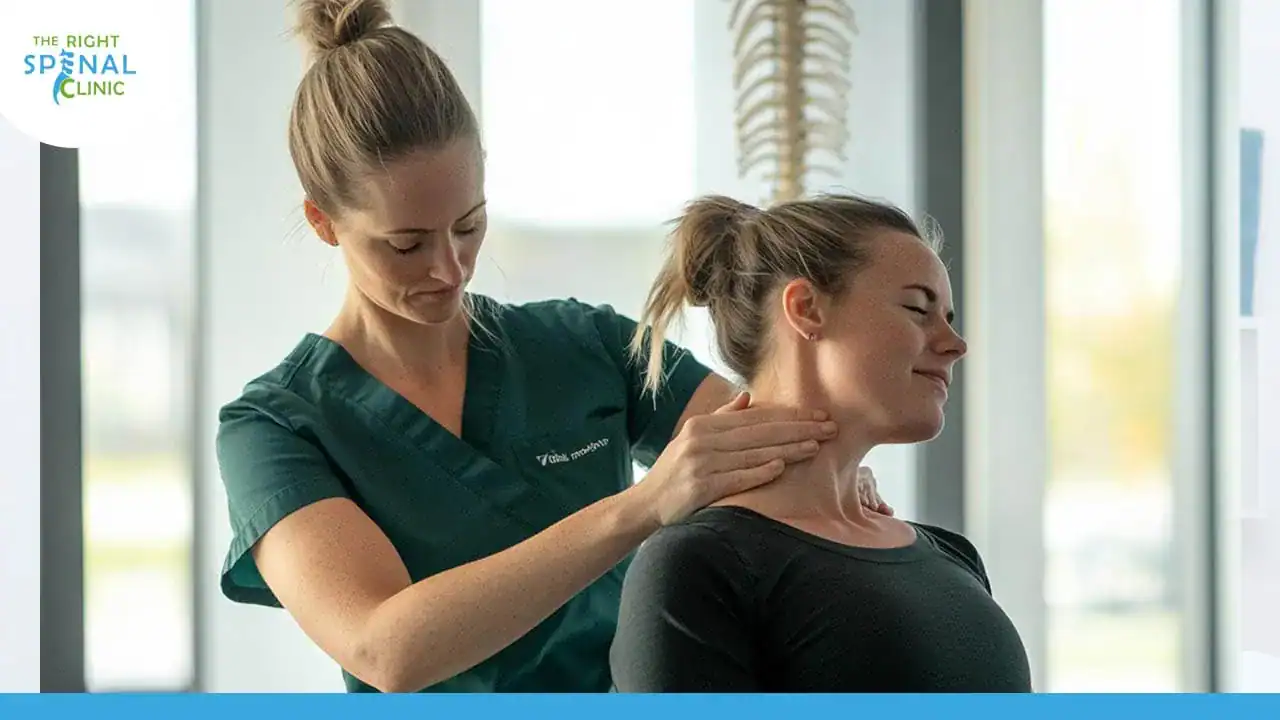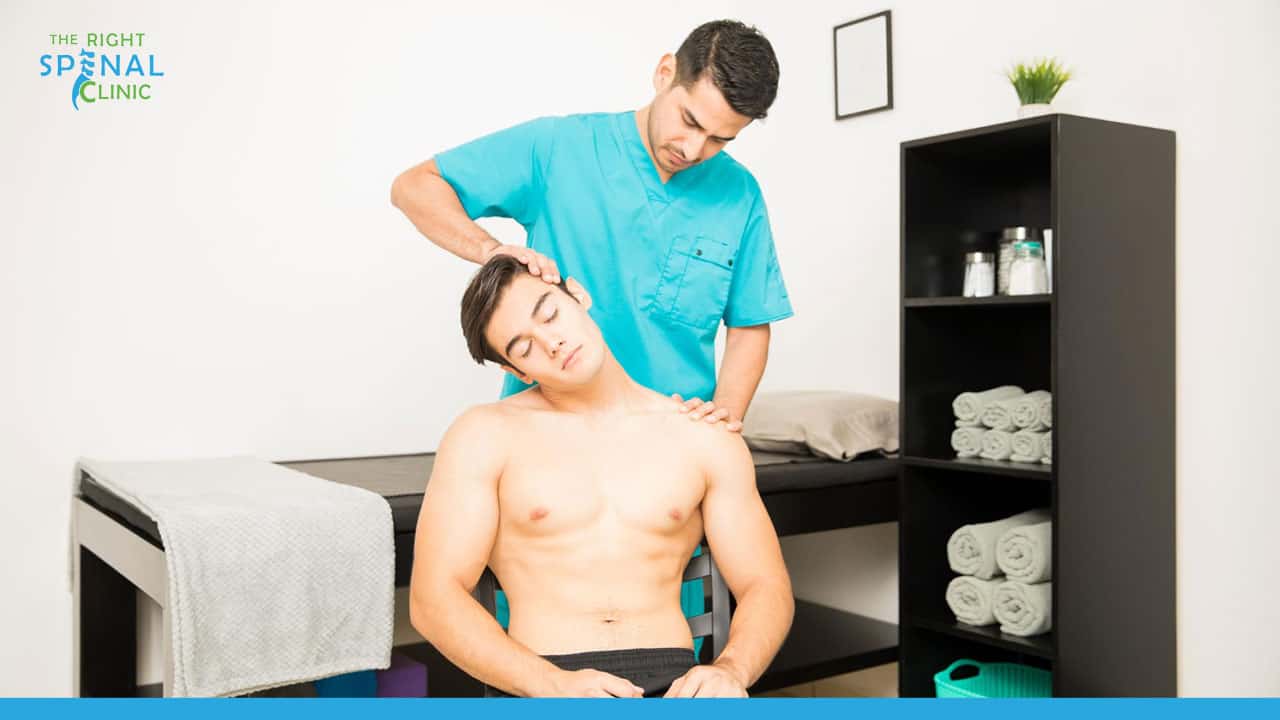
Tennis elbow, or lateral epicondylitis, is a repetitive strain injury that causes pain and inflammation around the outer part of the elbow, particularly at the lateral epicondyle. Despite its name, tennis elbow affects more than just tennis players—it can impact anyone involved in repetitive forearm and wrist motions, such as typing, painting, or playing racket sports like squash.
At The Right Spinal Clinic, we specialize in comprehensive care for tennis elbow, combining advanced sports medicine techniques and personalized physical therapy to alleviate pain and restore function without orthopedic surgery.
Key Takeaways:
- Tennis Elbow Overview: Tennis elbow (lateral epicondylitis) is caused by repetitive strain on forearm tendons, leading to pain and inflammation in the outer elbow. It affects both athletes and those in repetitive-motion occupations.
- Symptoms and Diagnosis: Common symptoms include pain, tenderness, weak grip, and worsened pain with specific movements. Diagnosis involves a physical exam, medical history, and possibly imaging tests like MRI.
- Causes and Risks: Repetitive motions and excessive strain on the forearm tendons, common in certain sports (e.g., tennis, squash) and jobs (e.g., typing), are primary causes.
- Treatment Options: Treatments include rest, ice, physical therapy, chiropractic care, and, for severe cases, corticosteroid injections or PRP therapy.
- Prevention and Care: Preventing tennis elbow involves modifying activities, using proper technique, and performing regular exercises. The Right Spinal Clinic offers personalized care for effective recovery and prevention of long-term issues.
What is Tennis Elbow?
According to the Mayo Clinic, Tennis elbow is an overuse injury where repetitive motion and excessive strain on the forearm muscles lead to irritation and tendinopathy of the common extensor tendons attached to the lateral epicondyle. This can cause pain, tenderness, and inflammation, especially during activities that involve gripping, lifting, or backhand strokes.
Causes of Tennis Elbow
Tennis elbow primarily arises from repetitive wrist and arm motions that place excessive strain on the tendons connecting the forearm muscles to the elbow. When these motions are repeated frequently, the tendons can develop small tears, leading to the inflammation and pain associated with lateral epicondylitis.
Occupational Risks: Certain professions are at higher risk of developing tennis elbow due to the nature of the work involved. Plumbers, painters, carpenters, and others who engage in repetitive hand and arm movements are particularly susceptible. The continuous strain on the elbow from tasks such as gripping tools, lifting, or twisting can lead to the overuse of the tendons and muscles, resulting in tennis elbow.
Sports-Related Causes: Sports, especially those involving racket use like tennis, squash, and badminton, are common causes of tennis elbow. According to the Cleveland Clinic, improper technique, overtraining, or using equipment that doesn't suit the player's physical capabilities can increase the risk. Repeated backhand strokes, particularly when performed with poor form or inadequate grip, put significant stress on the tendons.
Other Contributing Factors: Poor technique or inadequate equipment can exacerbate the risk of developing tennis elbow. For instance, using a racket with a grip that is too small or heavy can force the forearm muscles to work harder than necessary. Similarly, repetitive activities that involve improper posture or movement patterns can strain the elbow, increasing the likelihood of injury.
Signs and Symptoms of Tennis Elbow
Tennis elbow presents with a range of symptoms that can vary in intensity, often affecting daily activities and overall quality of life.
- Pain and Tenderness: Pain is usually localized on the outer elbow at the lateral epicondyle and often worsens with specific movements like lifting or gripping.
- Weak Grip Strength: A noticeable decrease in grip strength, making daily tasks challenging.
- Radiating Pain: Pain may extend down the forearm toward the wrist and hand, indicating more widespread tendon involvement.
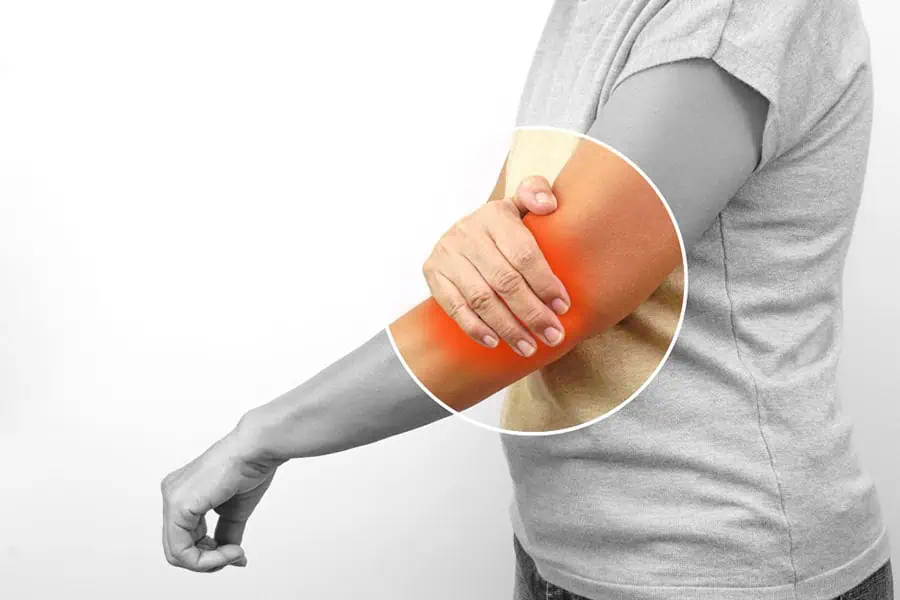
Diagnosing Tennis Elbow
Diagnosing tennis elbow involves a thorough evaluation by a healthcare provider to confirm the condition and rule out other potential causes of elbow pain.
Physical Examination and Medical History: The diagnosis of tennis elbow typically begins with a detailed physical examination and a review of the patient's medical history. During the exam, the physician will assess the affected arm, paying close attention to areas of pain and tenderness, particularly around the lateral epicondyle. They may also ask the patient to perform specific movements, such as extending the wrist or gripping an object, to evaluate the severity of the pain and identify any associated weakness in the forearm muscles.
Imaging Tests: While a physical examination is often sufficient to diagnose tennis elbow, imaging tests such as magnetic resonance imaging (MRI) or ultrasound may be recommended in certain cases. These tests can help rule out other conditions that may mimic the symptoms of tennis elbow, such as radial tunnel syndrome or arthritis. MRI and ultrasound are particularly useful for providing detailed images of the soft tissues, allowing the physician to assess the extent of tendon damage and inflammation.
Importance of Accurate Diagnosis: Accurate diagnosis is crucial for effective treatment of tennis elbow. Misdiagnosis or delayed diagnosis can lead to prolonged pain and potentially ineffective treatment strategies. By correctly identifying the condition, healthcare providers can tailor a treatment plan that addresses the specific needs of the patient, ensuring a more efficient recovery and preventing further complications.
Treatment Options for Tennis Elbow
At-Home Care and Self-Management
Resting the Affected Arm: One of the most effective initial treatments for tennis elbow is rest. Avoiding activities that exacerbate the symptoms, such as repetitive wrist and forearm movements, allows the tendons to heal and prevents further strain. It’s important to give the affected arm ample time to recover to avoid prolonging the injury.
Ice Therapy: Applying ice to the elbow can help reduce inflammation and numb the pain associated with tennis elbow. It is recommended to apply ice packs for 15-20 minutes several times a day, especially after activities that cause discomfort.
Over-the-Counter Pain Relief: Nonsteroidal anti-inflammatory drugs (NSAIDs) like ibuprofen or naproxen can be used to manage pain and reduce inflammation. These medications are effective in alleviating the discomfort associated with tennis elbow and can be easily incorporated into a self-care routine.
Use of a Counterforce Brace or Wrist Splint: A counterforce brace or wrist splint can provide additional support to the forearm and reduce the strain on the tendons during daily activities. These devices help distribute the load away from the injured area, which can significantly reduce pain and prevent further damage.
Professional Treatment Options
Physical Therapy: Physical therapy is a cornerstone of tennis elbow treatment, focusing on targeted exercises to strengthen and stretch the forearm muscles. A physical therapist will develop a personalized exercise program designed to improve grip strength, enhance flexibility, and promote tendon healing, ultimately reducing the risk of future injury.
Chiropractic Care: Chiropractic care involves adjustments and techniques aimed at relieving stress on the elbow. By addressing any misalignments or restrictions in the arm, shoulder, or upper back, chiropractors can help alleviate pain and improve the overall function of the affected area, aiding in the recovery process.
Ultrasound Therapy and Electrical Stimulation: These advanced therapeutic modalities can be used to promote healing and reduce inflammation in the affected tendons. Ultrasound therapy uses sound waves to stimulate blood flow and tissue repair, while electrical stimulation can help reduce pain and improve muscle function.
Corticosteroid Injections: For severe pain that doesn’t respond to conservative treatments, a healthcare or sports medicine provider may recommend corticosteroid injections. These injections deliver powerful anti-inflammatory medication directly to the affected area, providing significant relief from pain and swelling. However, they are typically considered when other treatments have not provided adequate relief.
Platelet-Rich Plasma (PRP) Therapy: PRP therapy is an advanced treatment option that involves injecting a concentration of the patient’s own platelets into the injured tendon to promote healing. This therapy is gaining popularity due to its potential to accelerate recovery and improve tendon health, especially in cases where traditional treatments have been ineffective.
Surgery: Surgical options for tennis elbow typically aim to remove damaged tissue, relieve tension on the tendons, and promote healing. Common surgical procedures include:
- Open Surgery: This traditional approach involves making an incision over the elbow to remove the damaged tendon tissue and reattach healthy tendon to the bone.
- Arthroscopic Surgery: A less invasive option, arthroscopy uses small incisions and a camera to guide the surgeon in removing damaged tissue and repairing the tendons.
- Percutaneous Tenotomy: This minimally invasive procedure involves using a needle or special tool to make small cuts in the tendon to stimulate healing.
Surgery is generally recommended only after six to twelve months when all other treatments have failed. Post-surgery, physical therapy is crucial for recovery, and it may take several months to regain full strength and function in the elbow.
Preventing Tennis Elbow
Preventing tennis elbow involves modifying activities to reduce strain, using proper technique and equipment in sports, and incorporating regular stretching and strengthening exercises for the forearm. These measures help maintain tendon health and prevent recurrence.
Why Choose The Right Spinal Clinic for Tennis Elbow Treatment?
At The Right Spinal Clinic, we offer personalized and comprehensive care for tennis elbow. Our process starts with a thorough physical examination and review of your medical history to create a treatment plan tailored to your specific needs. We provide a range of therapies, including targeted physical therapy, chiropractic care, and other evidence-based treatments to address elbow pain, reduce inflammation, and restore motion.
Our experienced team specializes in treating musculoskeletal conditions like tennis elbow, ensuring that each patient receives expert care designed to promote healing and prevent recurrence. Conveniently located in Tampa, FL, we make it easy to schedule appointments that fit your busy life, with minimal wait times and a patient-focused approach.
By choosing The Right Spinal Clinic, you’re selecting a dedicated partner in your journey to relieve pain and regain your strength.
Conclusion
Tennis elbow, or lateral epicondylitis, is a common condition caused by repetitive strain on the tendons of the forearm, leading to pain and discomfort in the elbow. While often associated with racket sports, this condition can affect anyone who engages in repetitive wrist and arm movements, including those in certain occupations. Recognizing the symptoms and seeking proper treatment is crucial to preventing the condition from becoming a chronic issue.
At The Right Spinal Clinic, we emphasize the importance of early intervention and personalized care. By addressing tennis elbow promptly with the right treatment plan, you can avoid long-term pain and return to your daily activities with confidence.
If you're experiencing symptoms of tennis elbow, don't hesitate to contact The Right Spinal Clinic today to schedule a consultation and take the first step toward a pain-free future. Our expert team is here to provide the comprehensive care you need to recover and thrive.
Recent Posts


